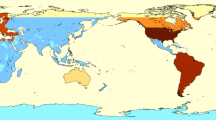Abstract
With the CHAMP and GRACE satellite gravity missions and the upcoming GOCE mission, millions of gravity-related observations are being released to the geodetic community. In order to provide an optimal gravity model in a statistical sense, it is common practice to combine satellite-only normal equations with prior information derived from terrestrial data or from previous satellite missions in the form of an existing gravity model. The weighting could be derived from formal error estimates, but more often these are adjusted based on heuristics like inspection of the residuals or of subset solutions. In recent years, rigorous approaches based on variance component estimation techniques have been developed and enjoy increasing popularity. At the same time, these techniques aim to provide more realistic error assessments of the combination solutions.
The problem that all these approaches face is that typically systematic inconsistencies exist between the prior information and the information obtained from different observation systems, which may dominate over the random errors. In this contribution, we investigate different methods that can deal with inconsistencies: model augmentation to accommodate for a vector of deterministic inconsistencies, and (partial) downweighting in a variance-component estimation procedure. These methods are tested thoroughly and applied to combine CHAMP data and normal equations with the EGM96 model.
Access this chapter
Tax calculation will be finalised at checkout
Purchases are for personal use only
Preview
Unable to display preview. Download preview PDF.
Similar content being viewed by others
References
Crocetto N, Gatti M, Russo P (2000) Simplified formulae for the BIQUE estimation of variance components in disjunctive observation groups, Journal of Geodesy 74, pp. 447–457
Fotopoulos G (2005) Calibration ofgeoid error models via a combined adjustment of ellipsoidal, orthometric and gravimetric geoid height data, Journal of Geodesy 79, pp. 111–123
Jekeli C (1999) The determination of gravitational potential differences from satellite-to-satellite tracking, Cel. Mech. Dyn. Astr. 75, pp. 85–100
Koch K-R (1986) Maximum Likelihood estimate of variance components, Bull Geod 60, pp. 329–338
Kotsakis (2005) A type of biased estimators for linear models with uniformly biased data, Journal of Geodesy 79, pp. 341–350
Kusche J (2003) A Monte-Carlo technique for weight estimation in satellite geodesy., J Geodesy 76, pp. 641–652
Kusche J, Schrama EJO, Jansen MJF Continental hydrology retrieval from GPS time series and GRACE gravity solutions, Proceedings Joint Assembly of IAG, IAPSO and IABO (Dynamic Planet), session G3, submitted
Lemoine FG, Kenyon SC, Factor JK, Trimmer RG, Pavlis NK, Chinn DS, Cox CM, Klosko SM, Luthcke SB, Torrence MH, Wang YM, Williamson RG, Pavlis EC, Rapp RH, Olsen TR (1998) The development of the joint NASA GSFC and the National Imagery and Map** Agency (NIMA) geopotential model EGM96. NASA/TP-1998-206861, NASA-GSFC, Greenbelt MD
Lerch FH, Marsh JG, Klosko SM, Patel GB, Chinn DS, Pavlis EC, Wagner CA (1991) An improved error assessment for the GEM-T1 gravitational model, J. Geophys. Res. 96, pp. 20023–20040
Mayer-Gürr T, Ilk KH, Eicker A, Feuchtinger M (2005) ITG-CHAMP01: a CHAMP gravity field model from short kinematic arcs over a one-year observation period, Journal of Geodesy 78, pp. 462–480
Rao CR (1971) Estimation of variance and covariance components-The MINQUE theory, J. of Multivariate Anal. 1, pp. 257–275
Rao CR (1973) Linear statistical inference and its applications, John Wiley and Sons, New York
Reubelt T, Götzelmann M, Grafarend EW A new CHAMP gravitational field model based on the GIS acceleration approach and two years of kinematic CHAMP data, submitted to Reigber C, Tapley B (eds.) New satellite mission results for the geopotential fields and their variations, proceedings of the Joint CHMAP/GRACE Science Meeting, 6th–8th July 2004, GFZ Potsdam, EGU
Schaffrin B (1987) Less sensitive tests by introducing stochastic linear hypotheses, Proc. Second International Tampere Conference in Statistics, Univ. of Tampere, pp 647–664
Schaffrin B and H.B. Iz (2001) Integrating heterogeneous data sets with partial inconsistencies, in Siderius M. (ed.), Gravity, Geoid and Geodynamics 2000, Springer, Berlin Heidelberg, pp. 49–54
Schwintzer P, Reigber Ch, Bode A, Kang Z, Zhu SY, Massmann F-H, Raimondo JC, Biancale R, Balmino G, Lemoine JM, Moynot B, Marty JC, Barlier F, Boudon Y (1997) Long-wavelength global gravity field models: GR1M4-S4, GRIM4-C4, Journal of Geodesy 71, pp. 189–208
Švehla D, Rothacher M (2003) Kinematic and reduced-dynamic precise orbit determination of low earth orbiters, Adv, Geosciences 1, pp. 47–56
Van Loon JP, Kusche J (2005) Stochastic model validation of satellite gravity data: a test with CHAMP pseudo-observations, in Jekeli C, Bastos L and Fernandes J (ed.) Gravity, Geoid and Space Missions, IAG symposia, vol. 129, Springer
Visser P, Sneeuw N, Gerlach C (2003) Energy integral method for gravity field determination from satellite orbit coordinates, Journal of Geodesy 77, pp. 207–216
Author information
Authors and Affiliations
Editor information
Editors and Affiliations
Rights and permissions
Copyright information
© 2007 Springer-Verlag Berlin Heidelberg
About this chapter
Cite this chapter
van Loon, J.P., Kusche, J. (2007). Towards an optimal combination of satellite data and prior information. In: Tregoning, P., Rizos, C. (eds) Dynamic Planet. International Association of Geodesy Symposia, vol 130. Springer, Berlin, Heidelberg. https://doi.org/10.1007/978-3-540-49350-1_51
Download citation
DOI: https://doi.org/10.1007/978-3-540-49350-1_51
Publisher Name: Springer, Berlin, Heidelberg
Print ISBN: 978-3-540-49349-5
Online ISBN: 978-3-540-49350-1
eBook Packages: Earth and Environmental ScienceEarth and Environmental Science (R0)




